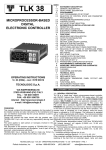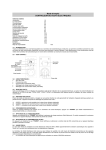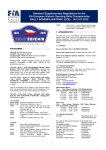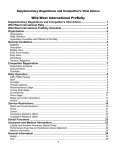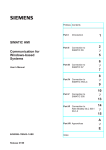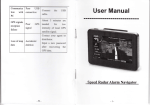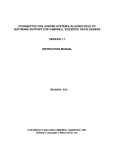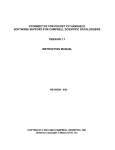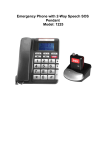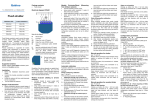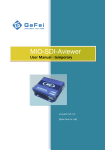Download Notification Server - User Manual - Alcatel
Transcript
Alcatel-Lucent OmniPCX Enterprise
Communication Server
Notification Server - User Manual
Legal notice:
Alcatel, Lucent, Alcatel-Lucent and the Alcatel-Lucent logo are trademarks of
Alcatel-Lucent. All other trademarks are the property of their respective
owners.
The information presented is subject to change without notice.
Alcatel-Lucent assumes no responsibility for inaccuracies contained herein.
Copyright © 2014 Alcatel-Lucent. All rights reserved.
The CE mark indicates that this product conforms to the following Council
Directives:
- 2004/108/EC (concerning electro-magnetic compatibility)
- 2006/95/EC (concerning electrical safety)
- 1999/5/EC (R&TTE)
Chapter 1
Overview
Introduction .............................................................................................. 1.1
Open/Close session procedure ......................................................... 1.1
Start application ............................................................................................. 1.1
Connection .................................................................................................... 1.2
Changing display language (optional) ........................................................... 1.2
Changing the password (optional) ................................................................. 1.2
Disconnection ................................................................................................ 1.3
References to other chapters ............................................................ 1.3
Chapter 2
Alarm Management
Overview .................................................................................................... 2.1
Adding an alarm call ............................................................................. 2.1
Consulting or modifying the parameters of an alarm call ....... 2.4
Deleting an alarm call ........................................................................... 2.5
!" # 0-1
Chapter 3
Hunt group management
Overview .................................................................................................... 3.1
Adding a hunt group ............................................................................. 3.1
Consulting or modifying a group's characteristics ................... 3.2
Deleting a hunt group ........................................................................... 3.3
Chapter 4
Administrator functions
Overview .................................................................................................... 4.1
Selecting a database ............................................................................. 4.1
Accounts management ........................................................................ 4.2
System ....................................................................................................... 4.3
PCX Info ........................................................................................................ 4.3
Info Timer ...................................................................................................... 4.3
Phone Sets .................................................................................................... 4.4
Misc. .............................................................................................................. 4.5
Log Files .................................................................................................... 4.7
IP addresses management ................................................................. 4.7
Starting and stopping the application ............................................ 4.8
Chapter 5
Logtables
0-2
!" # Generality .................................................................................................. 5.1
“General log” files .......................................................................................... 5.1
"log" and "stat" files ....................................................................................... 5.1
Creating files ............................................................................................ 5.1
“stat” and “log” viewing files ............................................................ 5.3
"stat" file ......................................................................................................... 5.3
"log" file .......................................................................................................... 5.4
Statistics label meaning ................................................................................. 5.7
Incident messages ................................................................................. 5.9
!" # 0-3
0-4
!" # 1.1
Introduction
The Alcatel-Lucent OmniPCX Enterprise Communication Server Notification Server application
enables calls which are accompanied by a text message (text messaging service) to be sent to
Advanced Reflexes or DECT (PWT) sets when requested by devices external to the PCX.
The application is installed on a Windows® 2000 Workstation PC which manages the
application and acts as the interface between the Alcatel-Lucent OmniPCX Enterprise CS PCX
and the external devices making such requests.
External devices may be alarm management systems, patient call systems, paging devices or
any other system compatible with the application.
The server PC can operate in client-server mode with networked Windows® (2000 or NT) PCs
that can then access certain management menus in the application. The client is the
Notification Server Configuration Tool.
1.2
Open/Close session procedure
1.2.1
Start application
From the desktop, select Start -> Programs -> Notification Server to open the “Notification
Server Configuration Tool” window.
!" # 1-1
Chapter
1.2.2
1
$%
Connection
To access the configuration menus you must be connected to the configuration application.
In the menu bar, select File -> Connect or click the
icon.
In the “Identification” window, enter admin in the User field and admin in the Password field,
then click OK.
The "admin" user and the "admin" password are configured by default when the system is
initialized. They are reserved for the administrator. The password can be modified later on.
Other users, who will have further access to the configuration menus are created by the
administrator.
1.2.3
Changing display language (optional)
This menu allows you to change the language used to display text in the configuration menus
and windows. Changing this will not, however, modify the content of messages defined or
transmitted by the Alcatel-Lucent OmniPCX Enterprise CS Notification Server.
Select Languages in the menu bar and click the desired language.
1.2.4
Changing the password (optional)
This window allows users to change their password (8 characters maximum), providing they
are logged on under their account. The password can also be managed by the administrator.
In the menu bar, select Configuration -> Modify Password to open the “Updating Password”
window.
1-2
!" # $%
Enter the current password in the Old Password field and then enter the new password twice
in the New and Confirmation fields.
Click OK to confirm or Cancel to quit the window without validation.
1.2.5
Disconnection
In the menu bar, select File -> Disconnect or click the
icon.
Select File -> Quit to close the "Notification Server - Configuration Tool" window.
1.3
References to other chapters
The rest of this manual includes the following chapters:
-
The chapter “Alarm management” describes how to specify the call characteristics sent to
the PCX following an alarm request. See Notification server - Administrator functions ,
-
The chapter “Hunt group management” describes how to specify the hunt groups called for
an alarm request. See Notification server - Administrator functions ,
-
The chapter “Administrator functions” (can only be accessed by the administrator),
describes how to configure the “Notification Server” environment and parameters. See
Notification server - Administrator functions ,
-
The chapter “Logtables” describes how to configure and view the files monitoring
Notification server activity. See Notification server - Logtables .
!" # 1-3
Chapter
1-4
1
$%
!" # 2.1
Overview
This menu is used to manage (Add, View/Update or Delete ) the different parameters defining
the call which will be transmitted to the PCX following an alarm request.
2.2
Adding an alarm call
In the menu bar, select Alarms -> Add or else click directly on the
icon to open the
"Alarms Management: Add" window:
-
Id: enter the identification of the alarm request: from 0 to 9999.
The Show button is used to display the list of identifiers already programmed.
-
Alarm Name: enter the name associated to the alarm (14 characters max.). It is displayed
on the set when the call is in progress.
-
Display This Message: is used to define, by clicking on this box, the message which is
transmitted during the call:
•
: the message defined in the Message field is transmitted.
•
: the message received from the external device is transmitted. In this case, as for
a message call, the name of the alarm is not transmitted and the first 14 characters of
the message are displayed instead of the name when the call is in progress.
-
Message: first click on Display This Message
!" # then enter the text message which is
2-1
Chapter
2
& '&
transmitted to the destination set (128 characters max.)
-
Management of the parameters which depend on the validity period: click the Period Add
button to open the window:
•
Urgency of the call:
•
: normal call,
•
•
Acknowledge Needed: is used to define if an acknowledgement is required to the
user:
•
: no acknowledgement;
•
•
•
•
: acknowledgement required.
Address:
Depending on type, the recipient is identified by:
• a directory/node number pair for only one set,
• a group number for a group of sets in the Notification Server sense,
Overflow: enter the directory number of the set or the identification of the group used
in case of an overflow (optional).
Validity Period:
• Click one or more days of the week which make up the period: start period left
column
end period right column
or select Every day
for each day of
•
•
2-2
: urgent call.
the week.
Enter the time period which applies to the period: From the first hour to the last (2
digits for the hours and 2 digits for the minutes), or select Every Hour
for a
period from 00h00 to 23h59.
The Existing button allows you to display all the time periods which have been
defined.
The [U] parameter at the start of the line indicates an urgent alarm.
The [A] parameter at the end of the line indicates that the user is required to
acknowledge the alarm.
!" # & '&
-
By selecting a period in the "Existing Periods" window and clicking OK, the parameters are
copied into the "Add period" window. They can be reused or modified before they are
validated.
-
Examples:
Every Monday
From Tues to Thurs, 08h00 to 18h00.
-
Click OK to validate or Cancel to close the window without registering the data.
-
The periods defined will be displayed in the Periods table.
Several validity periods can be specified (click Period: Add) on the same request. The
periods must not overlap but one period can be included in another.
!" # 2-3
Chapter
2
& '&
Example:
•
•
2.3
Monday and Tuesday from 08h00 to 12h00 and Monday and Tuesday from 12h01 to 18h59
Thursday from 08h00 to 20h00 and Thursday from 12h00 to 16h00.
-
By selecting a period, it is possible to modify it before validating.
-
Click Add to validate the alarm or Close to quit the window without validation.
Consulting or modifying the parameters of an alarm call
In the menu bar, select Alarms -> View:Update or else click directly on the
icon to
open the "Alarms Management View/Update" window:
2-4
!" # & '&
-
The characteristics of the first alarm listed will be displayed.
-
The Show button allows you to display the alarms which have already been defined.
By selecting an alarm in the "Existing alarms" window and clicking OK, all the parameters
of the alarm will be displayed.
By using the
buttons it is possible to browse through the parameters for the
alarms defined.
2.4
-
Carry out the modifications desired.
The Period Delete button allows you to delete the period selected.
-
Click Update to validate the modifications or Close to quit the window without validation.
Deleting an alarm call
In the menu bar, select Alarms -> Delete or else click directly on the
icon to open the
"Alarms Management: Delete" window:
-
The characteristics of the first alarm listed will be displayed.
-
The Show button allows you to list the alarms which have already been defined.
By selecting an alarm from the "Existing alarms" window and clicking OK, an alarm can be
displayed.
By using the
buttons it is possible to browse through the parameters for the
alarms defined.
-
Click Delete to erase the alarm selected, and confirm by clicking OK .
-
Exit the window by clicking Close.
!" # 2-5
Chapter
2-6
2
& '&
!" # 3.1
Overview
This menu allows you to manage (Add, View/Update, or Delete) the hunt groups of the sets
used for the Notification Server application.
3.2
Adding a hunt group
In the menu bar, select Groups -> Add or else click directly on the
icon to open
“Groups Management: Add” window:
-
Id: enter the group identification: G0 to G9999 (1000 groups max). The 0 are significant:
G1 G01.
The Show button allows you to display the hunt groups which have already been defined.
-
Name: This allows you to enter the name (up to 14 characters) of the hunt group. Only
used for a better identification.
-
Phone Sets Lists: Enter the list of the hunt group sets (minimum 1, maximum 20).
Enter the first number (10 digits maximum), and press
to move onto the next line,
etc.
In the same way as the user enters the list of sets, he must correspond the node number
of the recipient.
-
Group Type: to define the hunt group, click on
or
-
Sequential Group,
Parallel Group. The selected hunt group is indicated by
Cyclic Group
.
Click Add to validate the group without closing the window, Save to validate the group and
close the window or Close to quit the window without validating.
Important:
If a parallel group is composed of non-GAP DECT sets, the call parameters must be adjusted to
!" # 3-1
Chapter
3
( ') &
'&
be able to cover up to 20 sets.
As the 20 sets cannot be called at the same time, these parameters define the number of sets
which are called at the same time and the time-out before the call to the next sub-group. These
parameters must be adjusted according to the system configuration and the distribution of the
sets over the bases.
These parameters are
Server\bin\parallel.reg.
-
defined
in
the
file
C:\ProgramFiles\Alcatel-Lucent\Notification
Edit the parallel.reg file:
[HKEY_LOCAL_MACHINE\SOFTWARE\Alcatel-Lucent\Notification Server]
”PagingPar” = ”500”
”PagingPostes” = ”5”
”PagingRetry” = ”3”
”NoAlerRetry” = ”50”
•
•
•
•
3.3
"PagingPar" = time-out before the call to the next sub-group (in milli-seconds).
"PagingPostes" = number of sets called at the same time (sub-group).
"PagingRetry" = number of retransmission attempts when a DECT set is out of coverage.
"NoAlertRetry" = number of retransmission attempts when text messaging resources are
busy or if the set notification is already in progress.
-
Modify the value of the parameters.
-
Save and close the file.
-
Activate the new parameters by double clicking the file icon.
Consulting or modifying a group's characteristics
In the menu bar, select Groups -> View/Update or else directly click the
icon to open
the "Group Management: View/Update” window:
3-2
-
The characteristics of the first group listed will be displayed.
-
The Show button allows you to display the hunt groups which have already been defined.
By selecting a group in the "Existing groups" window and clicking OK, all parameters of the
group will be displayed.
!" # ( ') &
'&
buttons it is possible to browse through the parameters for the groups
defined.
3.4
-
Carry out the modifications desired.
-
Click Update to validate the modifications or Close to quit the window without validation.
Deleting a hunt group
In the menu bar, select Groups -> Delete or else click directly on the
icon to open the
"Groups Management: Delete" window:
-
The characteristics of the first group listed will be displayed.
-
The Show button allows you to display the list of groups already defined.
By selecting a group in the "Existing groups" window and clicking OK , the group will be
displayed.
By using the
buttons it is possible to browse through the parameters for the
groups defined.
-
Click Delete to erase the group selected and confirm by clicking OK .
-
Quit the window by clicking Close.
!" # 3-3
Chapter
3-4
3
( ') &
'&
!" # 4.1
Overview
Select Configuration from the menu bar and click the corresponding menu:
Note:
Only the "admin" user and users defined by the administrator can access:
-
Select Database,
-
Accounts Management,
-
System,
-
IP addresses Management,
Caution:
In some cases, after changing the configuration, the Notification Server must be shut down and
rebooted for changes to be applied (see Starting and stopping the application ).
4.2
Selecting a database
This window allows the user to choose a network database for a client PC. This database will
be common to both the server PC and the client PCs.
!" # 4-1
Chapter
4
&
Select the database and click OK to confirm or Cancel to quit the window without making
changes.
4.3
Accounts management
In this window it is possible to define which users will have access to the configuration menus
from the Connection menu.
-
To add a new user: click Add:
• Login: user name (8 characters max.).
• Passwd: password (8 characters max.).
• Powers:
•
= access all menus, even administrator rights.
•
= no access to system menus reserved for the administrator.
•
User Language: select the language which will be used after login: CAE = English;
FR0 = French.
Click Update to register a new user or Close to close the window without making changes.
-
4-2
To modify a user's parameters:
• Select a user by using the
keys.
!" # &
•
•
-
Modify the parameters.
Click Update to apply the modifications.
To delete a user:
• Select a user by using the
•
keys.
Click Delete to erase the user.
Note:
The Login and Powers of the "admin" user cannot be modified or deleted.
4.4
System
This window allows certain system parameters to be defined.
Caution:
This menu must not be used from a client PC.
Select the corresponding sub-menu:
4.4.1
4.4.2
-
Complete or modify the relevant fields.
-
Click Save to confirm the modifications without closing the window, Cancel to cancel the
modifications, or OK to confirm the modifications and close the window.
PCX Info
-
PCX Name: used to enter Alcatel-Lucent OmniPCX Enterprise CS name.
-
IP address of the PCX: used to enter Alcatel-Lucent OmniPCX Enterprise CS IP address.
Info Timer
!" # 4-3
Chapter
4
&
-
Timer PBX (1 to 999 seconds): when a call is set up, defines the maximum time the
Alcatel-Lucent OmniPCX Enterprise CS has to indicate that the call was received (20s by
default).
-
Phone Set Timer (1 to 999 seconds): defines the time at which, when there is no reply,
the call originally intended for a particular set will be diverted to the overflow sets (20s by
default).
-
Recovering Timer (1 to 999 seconds): defines when a normal call to a DECT handset will
be renewed
-
Sequential Groups Timer (1 to 999 seconds): defines the time at which, when there is no
reply, the call intended for a particular sequential or cyclic group will be transferred to the
following telephone set in the group (30s by default).
-
Parallel Groups Timer (1 to 999 seconds): defines the time at which, when there is no
reply, the call intended for a parallel group will be transferred to the overflow sets (30s by
default).
-
Ack. Parallel Groups Timer (1 to 999 seconds): defines the time at which, if the user has
not acknowledged the call, all members of the group must acknowledge the call
individually (400s by default). This timer is only taken into account on expiration of the
"Parallel Group Timer".
Remark:
When managing timers, remember that the length of time for routing a call to a DECT handset is longer
than that for routing a call to a Reflexes telephone set.
4.4.3
4-4
Phone Sets
!" # &
General Overflow Set (10 characters max.): directory number of the set or group identifier
used as a default overflow for all calls of the type urgent alarm call to one set (not a group) if
no overflow is defined in the call parameters.
It is possible to choose a specific ringer cadence for alarms that are either of urgent of normal
type. These values are between 1 and 6, the field does not have to be completed.
4.4.4
Misc.
-
Time Before Disconnection: default time (in seconds) at which the user will automatically
be disconnected from the configuration application (after a period of inactivity).
-
Communication Port: PC serial port definition used for the link with the external device(s).
• NoCom: no serial link.
• COM1 to COM4: serial port used.
• Multiv24: this mode allows the use of up to 8 ports (with the Multi port card).
The ports used should be recorded in the text file \Alcatel-Lucent\Notification
Server\base\dev_com. This file can be edited using Wordpad or Notepad.
COM1 to COM9 (4 characters) are available but only 8 may be used. Do not insert a line
space between the entries or at the end of the list.
!" # 4-5
Chapter
4
-
&
V24 Protocol: protocol definition used for the V24 link with the external device(s).
Single protocol:
• ALC = Standard protocol
• TAP = Specific protocol.
• SDK = Alcatel-Lucent OmniPCX Enterprise CS emulation with TAP.
• EML = Alcatel-Lucent OmniPCX Enterprise CS emulation.
Multi-protocol mode:
• USR = multi-protocol mode.
• UML = multi-protocol mode with Alcatel-Lucent OmniPCX Enterprise CS emulation.
In Multi-protocol mode, the different protocols used must be declared in the
\Alcatel-Lucent\Notification Server\base\process.txt text file (the file may be edited
using Wordpad or Notepad).
• One protocol per line with the .exe extension compulsory.
• The v24.exe protocol identifies the Alcatel-Lucent OmniPCX Enterprise CS Notification
Protocol and does not need to be declared as it is always active.
4-6
!" # &
The protocols are associated with the different
\Alcatel-Lucent\Notification Server\base\dev_com text file.
• One protocol per line associated with each port.
4.5
4.6
ports
used
in
the
Log Files
-
Log Files: directory where the "general log" files are stored.
-
csv & txt files: directory where the "log" and "stat" csv and txt files are stored.
-
Log Files Type: not used.
-
Date Format: definition of the date format which will be used in the "log" or "stat" files.
-
List Separator: definition of the list separator used in the "log" or "stat" files to ensure
compatibility with Excel.
• ",": Excel (French version).
• ";": Excel (English version).
-
Minimum Free Disk Space: in MegaBytes.
When the free disk space remaining is less than the value defined, the older "log" files are
deleted to compensate for this.
-
Log File Keeping Time: duration (in days) that "log" files are kept if there is sufficient
space on the disk.
IP addresses management
!" # 4-7
Chapter
4
&
Use this window to manage the IP addresses of the only external devices which communicate
with the Alcatel-Lucent OmniPCX Enterprise CS Notification Server.
The IP address of the PC server is defined by default (localhost). The address can be modified
but cannot be deleted.
The checking process starts as soon as two addresses are present in the table, including
server PC address. If an unidentified address if detected a message is stored in the "general
log" file.
To cancel the IP address check process, delete all addresses except server PC address.
-
To add a new address: click Add:
• Name: name of the external device.
• IP address: IP address of the external device.
Click Update to register a new address or Close to close the window without making
changes.
-
To modify address parameters:
• Select an address by using the
•
•
-
4.7
Modify the parameters.
Click Update to apply the modifications.
To delete an address:
• Select an address by using the
•
keys.
keys.
Click Delete to delete the address.
Starting and stopping the application
1. From the desktop, select My Computer -> Control Panel -> Services.
4-8
-
In the "Services" window, select Notification Server, then click Stop.
-
When the application has shut down, click Start to restart it.
!" # 5.1
Generality
Traffic Observation allows to generate the following files:
5.1.1
-
“General Log” files.
-
“Log” files.
-
“Stat” files.
“General log” files
All activity within the Notification Server application is recorded daily in a "general log" file.
These files are stored in the directory defined in the "Configuration->System->Log Files"
window (by default in C:\Program Files\Alcatel-Lucent\Notification Server\log), and its name is
of the type log.DD_MM_YYYY, with:
-
DD = day (0 to 31).
-
MM = month (1 to 12).
-
YYYY = year (0 to 9999).
Example:
C:\Program Files\Alcatel-Lucent\Notification Server\log\log. 21_02_1998.
These files are automatically deleted each day after they have been stored for 45 days (or
depending on the "Log File Keeping File" parameter), or sooner if there is insufficient space on
the PC's hard disk ("Minimum Free Disk Space" setting).
These files are ASCII files and can be edited or printed (Ex: WordPad).
5.1.2
"log" and "stat" files
From the "general log" file, a "log" file and a "stat" file can be generated for each day:
-
The "stat" files presents a certain number of statistics about the daily activity of the
application.
-
The "log" files presents an overflowing trace of the calls treated by the application.
These files are generated in .txt and .csv. and sizes.
Note:
These files can be generated from the PC server.
5.2
Creating files
These files are created from the menu "Tools":
!" # 5-1
Chapter
5
'
*
1. Generation of files during the day
• Click on Generate Today Log, valid Ok: immediate generation of "log" files from
"general log"file of the day.
• Click on Generate Today Stat, valid Ok: immediate generation of "stat" files from the
"general log" file of the day.
2. Generation of files from the previous days
• Click on Generate logs:
Select a "general log" file depending on the wished date, e.g.: log.15_06_98 and click
on Ok to generate the "log" files corresponding
To visualize the created "log.xx_xx_.txt" file, click on Show Logs
5-2
!" # '
*
•
Select a "log" file, e.g.: log.15_06_98.txt and click on Ok to display the content (see file
description in the maintenance chapter).
Click on Generate stats :
the procedure is the same to generate the "stat" files and visualize Show Stats the
content of "stat_log.xx_xx_xx.txt" files (see previously).
5.3
“stat” and “log” viewing files
5.3.1
"stat" file
These files are of the type: stat12_03_98.csv or stat12_03_98.txt .
Example:
stat12_03_98.txt file open in WordPad.
Notification Server Statistics - 12/03/1998
Number of acknowledged calls before timeout
(all types)
+----------+----------+
+----------+----------+
|Completed |
Mean |
|
Other |
Mean |
|
calls | Duration |
|
Calls | Duration |
|
| (seconds)|
|
| (seconds)|
+----------+----------+
+----------+----------+
|
00640 |
00024 |
|
00369 |
00040 |
+----------+----------+
+----------+----------+
Alarms acknowledgment mean duration
(A type - in seconds)
+----------+----------+----------+----------+
|
Subset | Parallel |Sequential|
Cyclic |
|
Calls |
Group |
Group |
Group |
|
|
Calls |
Calls |
Calls |
+----------+----------+----------+----------+
|
00025 |
00020 |
00033 |
00042 |
+----------+----------+----------+----------+
Number of unconfigured calls
+----------+----------+
|
Urgent | Standard |
|
Alarms |
Alarms |
|
|
|
+----------+----------+
|
00027 |
00036 |
+----------+----------+
+----------+
|
00065 |
+----------+
Out_of_coverage subsets
!" # 5-3
Chapter
5
'
*
+-----------------+-------------------+
|
Subset |
Number of timer |
|
|
out_of_coverage |
+-----------------+-------------------+
|
3020 |
0153 |
+-----------------+-------------------+
|
3021 |
0081 |
+-----------------+-------------------+
Out_of_service subsets
+-----------------+-------------------+
|
Subset |
Number of timer |
|
|
out_of_service |
+-----------------+-------------------+
|
3003 |
0027 |
+-----------------+-------------------+
Non-existent subsets
+-----------------+-------------------+
|
Subset |
Number of calls |
|
|
to non existent |
+-----------------+-------------------+
|
3333 |
0063 |
+-----------------+-------------------+
Unanswered subsets calls
+-----------------+-------------------+
|
Subset |
Number of |
|
| unanswered calls |
+-----------------+-------------------+
|
3000 |
0207 |
+-----------------+-------------------+
|
3003 |
0054 |
+-----------------+-------------------+
|
3010 |
0009 |
+-----------------+-------------------+
Unanswered parallel group calls
+-----------------+-------------------+
|
Subset |
Number of |
|
| unanswered calls |
+-----------------+-------------------+
|
3003 |
0045 |
+-----------------+-------------------+
|
3010 |
0072 |
+-----------------+-------------------+
Unanswered sequential group calls
+-----------------+-------------------+
|
Subset |
Number of |
|
| unanswered calls |
+-----------------+-------------------+
|
3000 |
0135 |
+-----------------+-------------------+
|
3003 |
0144 |
+-----------------+-------------------+
|
3010 |
0090 |
+-----------------+-------------------+
5.3.2
"log" file
These files are of the type : log12_03_98.csv
Example:
log12_03_98.txt file open in WordPad.
5-4
!" # '
*
+-----------+------+----------+--------------+---+----+-+-----+-----+---+---+---+--+
|
|
|alarm idf |
|
|
|A|
|dura-|
|tim|
| |
|
date
| time |or called | label
|typ|call|L|end |tion |Ano|out|deb|st|
|
|
|number
|
|
|
|T|time |(sec)|
|
|
| |
|-----------|------|----------|--------------|---|----|-|-----|-----|---|---|---|--|
|12/03/1998 |08:48 |1000>74542|
fire| A |seq | |08:48|
7|
|
|
| |
|-----------|------|----------|--------------|---|----|-|-----|-----|---|---|---|--|
|12/03/1998 |08:48 |1000>74542|
fire| A |seq | |08:49|
42|
| Y |
| |
|-----------|------|----------|------------- |---|----|-|-----|-----|---|---|---|--|
|12/03/1998 |08:53 |1000>74542|
fire| A |seq | |08:54|
60|
| Y |ps | |
|-----------|------|----------|--------------|---|----|-|-----|-----|---|---|---|--|
|12/03/1998 |08:55 |1000>74542|
fire| A |seq | |
|
55|
| Y |
|KO|
|-----------|------|----------|--------------|---|----|-|-----|-----|---|---|---|--|
|12/03/1998 |08:57 |1000>74542|
fire| A |cycl| |08:57|
23|
| Y |
| |
|-----------|------|----------|--------------|---|----|-|-----|-----|---|---|---|--|
|12/03/1998 |08:59 |1000>74542|
fire| A |cycl| |
|
55|
| Y |
|KO|
|-----------|------|----------|--------------|---|----|-|-----|-----|---|---|---|--|
|12/03/1998 |09:00 |1000>74542|
fire| A |cycl| |09:01|
64|
| Y |ps | |
|-----------|------|----------|--------------|---|----|-|-----|-----|---|---|---|--|
|12/03/1998 |09:02 |1000>74542|
fire| A |par | |09:02|
8|
|
|
| |
|-----------|------|----------|--------------|---|----|-|-----|-----|---|---|---|--|
|12/03/1998 |09:04 |1000>74542|
fire| A |par | |09:05|
39|
| Y |
| |
|-----------|------|----------|--------------|---|----|-|-----|-----|---|---|---|--|
|12/03/1998 |09:05 |1000>74542|
fire| A |par | |09:06|
24|
| Y |ps | |
|-----------|------|----------|--------------|---|----|-|-----|-----|---|---|---|--|
|12/03/1998 |09:53 |1000>74542|
1000_fire| A |cycl| |
| 102|
| Y |grp| |
|12/03/1998 |09:55 | G02=73307|
1000_fire| D |par | |09:55|
9|
|
|
| |
|-----------|------|----------|------------ |---|----|-|-----|-----|---|---|---|--|
|12/03/1998 |09:55 |1000>74542|
1000_fire| A |cycl| |
| 148|
| Y |grp| |
|12/03/1998 |09:57 | G02=73307|
1000_fire| D |par | |09:58|
55|
| Y |
| |
|-----------|------|----------|--------------|---|----|-|-----|-----|---|---|---|--|
|12/03/1998 |09:58 |
3003|
water pump| C |ps | |
|
21|
| Y |
|KO|
|-----------|------|----------|--------------|---|----|-|-----|-----|---|---|---|--|
|12/03/1998 |10:01 |2222>73566|
2222_Alert| A |ps | |10:01|
7|
|
|
| |
|-----------|------|----------|--------------|---|----|-|-----|-----|---|---|---|--|
|12/03/1998 |10:01 |2222>73566|
2222_Alert| A |ps | |
| 114|
| Y |grp|KO|
|12/03/1998 |10:02 | G01=73307|
2222_Alert| D |cycl| |
|
94|
| Y |
| |
|-----------|------|----------|--------------|---|----|-|-----|-----|---|---|---|--|
|12/03/1998 |10:04 |2222>73566|
2222_Alert| A |ps | |
|
56|
| Y |grp| |
|12/03/1998 |10:04 | G01=73307|
2222_Alert| D |cycl| |10:05|
36|
| Y |
| |
|12/03/1998 |10:05 |2222>73566|
2222_Alert| A |ps | |
|
24|
| Y |grp| |
+-----------+------+----------+--------------+---+----+-+-----+-----+---+---+---+--+
+-----------+------+----------+--------------+---+----+-+-----+-----+---+---+---+--+
|
|
|alarm idf |
|
|
|A|
|dura-|
|tim|
| |
|
date
| time |or called | label
|typ|call|L|end |tion |Ano|out|deb|st|
|
|
|number
|
|
|
|T|time |(sec)|
|
|
| |
|-----------|------|----------|--------------|---|----|-|-----|-----|---|---|---|--|
|-----------|------|----------|--------------|---|----|-|-----|-----|---|---|---|--|
|12/03/1998 |10:05 | G01=73307|
2222_Alert| D |cycl| |10:05|
4|
|
|
| |
|-----------|------|----------|--------------|---|----|-|-----|-----|---|---|---|--|
|12/03/1998 |10:10 |1000>74542|
1000_fire| A |par | |
|
66|
| Y |grp| |
|12/03/1998 |10:10 | G01=73307|
1000_fire| D |cycl| |10:11|
35|
| Y |
| |
|-----------|------|----------|--------------|---|----|-|-----|-----|---|---|---|--|
|12/03/1998 |10:11 |1000>74542|
1000_fire| A |par | |
| 126|
| Y |grp|KO|
|12/03/1998 |10:12 | G01=73307|
1000_fire| D |cycl| |
|
95|
| Y |
| |
|-----------|------|----------|--------------|---|----|-|-----|-----|---|---|---|--|
|12/03/1998 |10:17 |1000>74542|
1000_fire| A |ps |N|
|
1| U |
|
|KO|
|-----------|------|----------|--------------|---|----|-|-----|-----|---|---|---|--|
|12/03/1998 |10:18 |1000>74542|
1000_fire| A |ps | |10:18|
4| U|
|ps | |
|-----------|------|----------|--------------|---|----|-|-----|-----|---|---|---|--|
|12/03/1998 |10:19 |1000>74542|
1000_fire| A |seq | |
|
64| U| Y |
|KO|
|-----------|------|----------|--------------|---|----|-|-----|-----|---|---|---|--|
|12/03/1998 |10:21 |1000>74542|
1000_fire| A |seq | |10:22|
66| U| Y |ps | |
|12/03/1998 |10:25 |
G01|
water pump| C |seq | |10:25|
2|
|
|
| |
|-----------|------|----------|--------------|---|----|-|-----|-----|---|---|---|--|
|-----------|------|----------|--------------|---|----|-|-----|-----|---|---|---|--|
|12/03/1998 |10:41 |1000>74542|
1000_fire| A |ps |N|
|
97| C | Y |
|KO|
|-----------|------|----------|--------------|---|----|-|-----|-----|---|---|---|--|
|12/03/1998 |10:55 |2222>73566|
2222_Alert| A |ps | |10:57| 102| C | Y |ps | |
|-----------|------|----------|--------------|---|----|-|-----|-----|---|---|---|--|
|12/03/1998 |10:58 |1000>74542|
1000_fire| A |ps |N|
|
0| S |
|
|KO|
|-----------|------|----------|--------------|---|----|-|-----|-----|---|---|---|--|
|12/03/1998 |22:00 |
1600|*config error*|
|
|N|
|
0|
|
|
|KO|
+-----------+------+----------+--------------+---+----+-+-----+-----+---+---+---+--+
Number of calls : : 28
!" # 5-5
Chapter
5
'
*
Parameters :
-
date time : date and time of the external request.
-
alarm idf or called number : number of the alarm or the number called.
• number of the alarm > last set called.
• hunt group identifier = last set called (group overflow).
-
label : name displayed at the time of the call.
-
type : type of call
• A = alarm call.
• C = message call.
• D = overflow call.
-
call : call destination
• ps = set.
• seq = sequential group.
• cycl = cyclical group.
• par = parallel group
-
ALT : N = message not delivered.
” = message delivered.
-
end time : time when the request processing ended.
-
duration (sec): duration of the request processing ended.
-
Ano : anomalies
• C = out-of-coverage.
• S = out-of-service.
• U = Undefined set.
• ” = no anomaly.
-
time out : temporization
• Y = time out occurred.
• ” = no time-out.
-
deb : type of overflow
• ps = overflow on set.
• grp = overflow on group
-
st : KO = call undelivered or not acknowledged before the time out occurs.
Example 1 :
+-----------+------+----------+--------------+---+----+-+-----+-----+---+---+---+--+
|
|
|alarm idf |
|
|
|A|
|dura-|
|tim|
| |
|
date
| time |or called | label
|typ|call|L|end |tion |Ano|out|deb|st|
|
|
|number
|
|
|
|T|time |(sec)|
|
|
| |
|-----------|------|----------|--------------|---|----|-|-----|-----|---|---|---|--|
|12/03/1998 |08:48 |1000>74542|
fire| A |seq | |08:48|
7|
|
|
| |
|-----------|------|----------|--------------|---|----|-|-----|-----|---|---|---|--|
Reception of alarm 1000, call of a sequential group, delivered call, call taken after 7seconds.
Example 2 :
5-6
!" # '
*
+-----------+------+----------+--------------+---+----+-+-----+-----+---+---+---+--+
|
|
|alarm idf |
|
|
|A|
|dura-|
|tim|
| |
|
date
| time |or called | label
|typ|call|L|end |tion |Ano|out|deb|st|
|
|
|number
|
|
|
|T|time |(sec)|
|
|
| |
|-----------|------|----------|--------------|---|----|-|-----|-----|---|---|---|--|
|12/03/1998 |08:53 |1000>74542|
fire| A |seq | |08:54|
60|
| Y |ps | |
|-----------|------|----------|--------------|---|----|-|-----|-----|---|---|---|--|
Reception of the alarm1000, call of a sequential group, delivered call, end of "sequential group
overflow timer", call overflow to a set, call taken after 60 seconds.
Example 3 :
+-----------+------+----------+--------------+---+----+-+-----+-----+---+---+---+--+
|
|
|alarm idf |
|
|
|A|
|dura-|
|tim|
| |
|
date
| time |or called | label
|typ|call|L|end |tion |Ano|out|deb|st|
|
|
|number
|
|
|
|T|time |(sec)|
|
|
| |
|-----------|------|----------|--------------|---|----|-|-----|-----|---|---|---|--|
|12/03/1998 |09:53 |1000>74542|
1000_fire| A |cycl| |
| 102|
| Y |grp| |
|12/03/1998 |09:55 | G02=73307|
1000_fire| D |par | |09:55|
9|
|
|
| |
|-----------|------|----------|--------------|---|----|-|-----|-----|---|---|---|--|
Reception of the alarm 1000, call of a cyclical group, delivered call, end of the "cyclical group
overflow" timer, call overflow to a parallel group, call taken after 111 seconds.
Example 4 :
+-----------+------+----------+--------------+---+----+-+-----+-----+---+---+---+--+
|
|
|alarm idf |
|
|
|A|
|dura-|
|tim|
| |
|
date
| time |or called | label
|typ|call|L|end |tion |Ano|out|deb|st|
|
|
|number
|
|
|
|T|time |(sec)|
|
|
| |
|-----------|------|----------|--------------|---|----|-|-----|-----|---|---|---|--|
|12/03/1998 |09:58 |
3003|
water pump| C |ps | |
|
21|
| Y |
|KO|
|-----------|------|----------|--------------|---|----|-|-----|-----|---|---|---|--|
Reception of a request of message type, call of the 3003 set, delivered call, end of the "set
overflow" timer, no overflow, call not taken, memorised in the set.
Example 5 :
+-----------+------+----------+--------------+---+----+-+-----+-----+---+---+---+--+
|
|
|alarm idf |
|
|
|A|
|dura-|
|tim|
| |
|
date
| time |or called | label
|typ|call|L|end |tion |Ano|out|deb|st|
|
|
|number
|
|
|
|T|time |(sec)|
|
|
| |
|-----------|------|----------|--------------|---|----|-|-----|-----|---|---|---|--|
|12/03/1998 |10:19 |1000>74542|
1000_fire| A |seq | |
|
64| U | Y |
|KO|
|-----------|------|----------|--------------|---|----|-|-----|-----|---|---|---|--|
Reception of alarm 1000, call of a sequential group, call delivered, end of the "sequential
group overflow", call not taken, undefined last call and no programmed overflow.
Example 6 :
+-----------+------+----------+--------------+---+----+-+-----+-----+---+---+---+--+
|
|
|alarm idf |
|
|
|A|
|dura-|
|tim|
| |
|
date
| time |or called | label
|typ|call|L|end |tion |Ano|out|deb|st|
|
|
|number
|
|
|
|T|time |(sec)|
|
|
| |
|-----------|------|----------|--------------|---|----|-|-----|-----|---|---|---|--|
|12/03/1998 |10:25 |
G01|
water pump| C |seq | |10:25|
2|
|
|
| |
|-----------|------|----------|--------------|---|----|-|-----|-----|---|---|---|--|
Reception of a request of message type, call of a sequential group G01, delivered call, call
taken after 2 seconds.
5.3.3
Statistics label meaning
Message
Definition
Number of acknowledged calls before
timeout
Details all calls sent by the application
(messages and alarms).
!" # 5-7
Chapter
5-8
5
'
*
Message
Definition
Completed calls
Acknowledged messages, OK status in log
file.
Mean duration
Time elapsed (in seconds) between the onset
of call and its acknowledgement by reveiver (if
call is acknowledged).
Other calls
Any other type of calls generating an error.
Mean duration
Time elapsed (in seconds) between the onset
of call and its acknowledgement by reveiver (if
call is acknowledged).
Message
Definition
Alarms acknowledgement mean duration
Time elapsed (in seconds) between the onset
of call and its aknowledgement by reveiver (if
call is aknowledged). Time encompassing all
types of calls.
Subset calls
The final receiver is a terminal.
Parallel group calls
The final receiver is a parallel group.
Sequential group calls
The final receiver is a sequential group.
Cyclic group calls
The final receiver is a cyclic group.
Urgent alarms
Average time elapsed for urgent calls.
Standard alarms
Average time elapsed for non urgent calls.
Message
Définition
Number of unconfigured calls
Details alarms set but not noted inthe database (wrong alarm number, non existent
alarm...).
Message
Definition
Out of coverage subset
Unreachable sets (out of coverage).
Subset
Unreacheable set numbers.
Number of times out of coverage
Number of times when set(s) are seen as unreachable.
Message
Definition
Out of service subset
Out of service sets.
Subset
Out of service set numbers.
Number of times out of service
Number of times when set(s) are seen as out
of service.
Message
Definition
Non existent subset
Sets defined as alarm sets, but not equipped
to receive alarms.
!" # '
*
5.4
Message
Definition
Subset
Set number.
Number of calls to non existent
Number of calls (alarm+message) to these
sets.
Message
Definition
Unanswered subset calls
Sets that did not acknowledge a message.
Subset
Set number.
Number of unanswered calls
Number of calls (alarm+message) to these
sets.
Message
Definition
Unanswered parallel group calls
Parallel groups that did not acknowledge a
message.
Subset
Set (group) number.
Number of unanswered calls
Number of calls (alarm+message) to these
sets.
Message
Definition
Unanswered sequential group calls
Sequential groups that did not acknowledge a
message.
Subset
Set (group) number.
Number of unanswered calls
Number of calls (alarm+message) to these
sets.
Incident messages
The "general log" files store the incident messages. These messages have the following
format :
dd/mm/yyyy hh:mm:ss t=s:####=text with :
-
dd : day (0 to 31)
-
mm : month (1 to 12)
-
yyyy : year (0 to 99)
-
hh : hour (0 to 23)
-
mm : minutes (0 to 59)
-
ss : seconds (0 to 59)
-
t : type of incident
• P : performance management,
• incident number from 0 to 999.
• S : software error,
incident number from 1000 to 1999.
!" # 5-9
Chapter
5
•
•
•
'
*
M : database update,
incident number from 2000 to 2999.
C : configuration error, general activity of the application.
incident number from 3000 to 3999.
-
s : the severity of the incident.
• 0 : critical. The application can't continue and resets itself automatically (all the
application or part of it.)
• 1 : major. External mechanism does not function, the request which has been sent is
maybe lost. There is no automatic reset.
• 2 : minor. Minor external disruption
• 3 : no external disruption
• 4 : unspecified. Used for the performance and general management messages.
-
#### : incident number.
-
text : ASCII text describing the incident.
Example:
26/02/1998 16:26:55 C =4:3011 serial device in input : COM1.
5-10
!" #







































